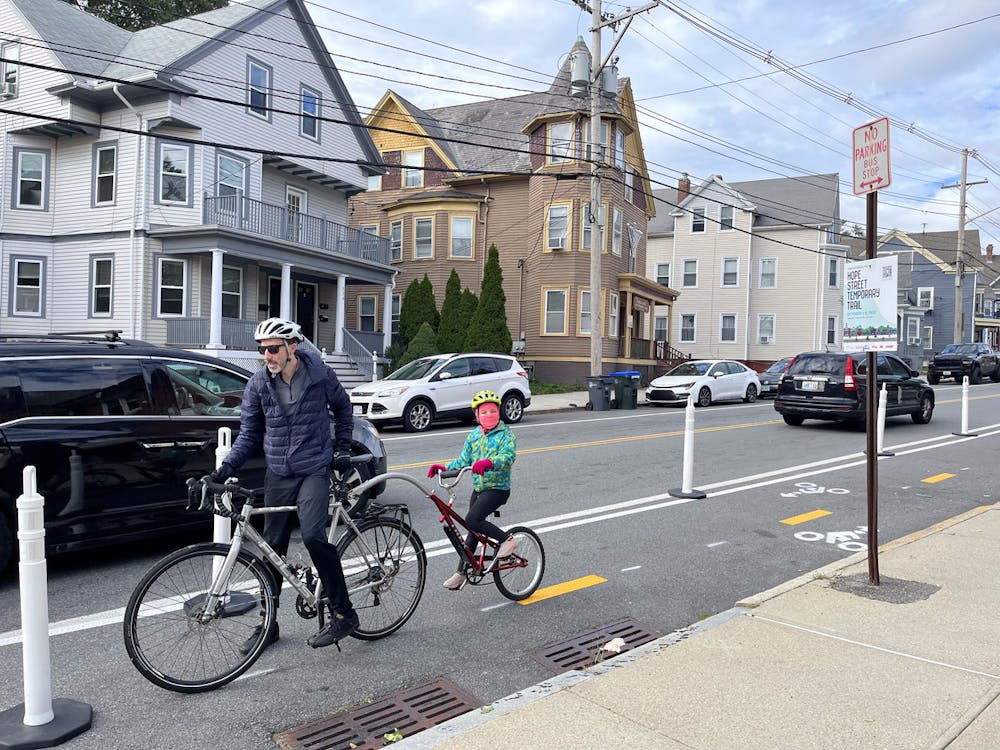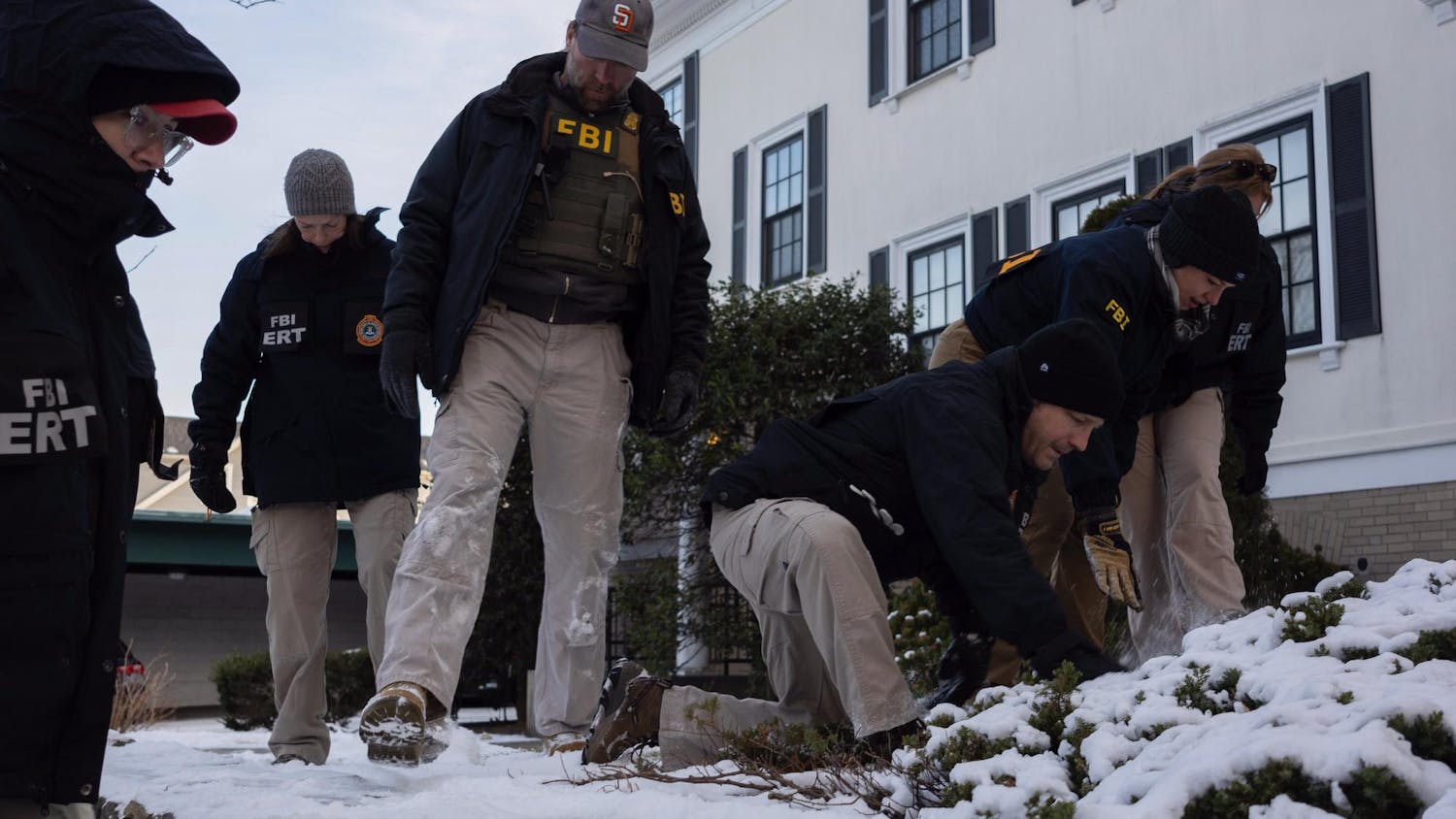A long-planned temporary bike path on Hope Street went up for eight days earlier this month in an attempt to show residents and business owners what a mixed-use trail might look like on one mile of the busy East Side thoroughfare.
Overseen by the Providence Streets Coalition with the permission of the city, the Hope Street Temporary Trail replaced a lane of parking on the east side of the street between Olney and Lauriston streets from Oct. 1 to 8, creating a path for bikers, joggers, skaters and walkers, according to the Providence Streets Coalition website. The path served as a demonstration of what a permanent trail on Hope Street might look like, said Liza Burkin, lead organizer for the coalition.
After the release of the 2019 draft of a “Great Streets” plan, which laid out a roadmap to creating “safe, equitable and sustainable” streets, an “urban trail” running up Hope Street was the most requested change to include in the 2020 version, Burkin said. In spring 2021, the coalition began discussing running the pilot path, she added.
“This type of installation is the gold standard,” Burkin said, calling it the “highest level of community engagement.”
Residents, she explained, had the chance to experience the potential path “years ahead of a permanent infrastructure change.”
Providence has not announced specific plans or funding to create a permanent bike path, according to the coalition’s website. As a next step, the coalition will analyze data collected about the path, including more than 1,000 “intercept surveys,” counts of the number of trail users and business surveys, Burkin said. That data will go to the city — which is also conducting its own survey — as well as community members in the Hope Village and Mount Hope neighborhoods for future planning purposes, Burkin said.
Alex Taylor, a resident of the East Side who tries to run most of his errands by bike, said the temporary trail’s impact on his rides “shocked” him.
Taylor rode the trail every day he was in Providence while it was in operation, noting that he normally does not consider biking infrastructure in choosing his routes.
“I didn’t realize the level of stress that I do have in that environment,” he said. “With that lane in there, I’m not constantly paying attention to eight feet behind me over my left shoulder.”
The trail elicited a “wide range of reactions,” Burkin said. “We had a lot of folks really love it and a lot of folks did not. And that was expected.”
Most frequently, Burkin’s team heard praise for the physical protection from traffic created by bollards — as well as travelers who appreciated extra space on the streets to walk in.
Few other urban trails would require the level of parking removal required in the Hope Street trail, Burkin said — which is why the project required a “real hard test and real hard look” through the pilot trail.
“It’s not the slam dunk that the other trails have been,” she noted.
“I was really impressed with the fortitude of the city,” Taylor said. “Even though there’s loud voices saying we shouldn’t do it, saying, ‘We’re going to go ahead and try to see what we learn’ — it was uncharacteristically brave of municipal government.”
The trail temporarily eliminated 132 parking spaces, according to the coalition’s estimates. Those spots represent 9% of the 1318 total spaces in the area — and most are typically not in use, according to the coalition.
Twenty-three businesses on Hope Street, including Rhody Craft, Bubbie’s Deli and The Camera Werks, wrote an open letter to Mayor Jorge Elorza expressing their skepticism of the plan and the data, as it was “gathered by agenda-driven volunteers.”
“We merchants, along with the overwhelming majority of our customers and neighbors, don’t feel that Hope Street is a viable location for an urban trail,” the letter said.
The letter cites Hope’s need to attract “customers from far and wide” and accommodate school buses and delivery vehicles.
Pat Zacks, owner of The Camera Werks, said that while she has not “done the numbers yet,” her business was slower that week, though that may have had to do with the Jewish High Holy Days.
Limited space on Hope created backlogs, Zacks said, especially when a UPS truck had to stop for a delivery. Parking on side streets can also make errands that require carrying large items more difficult, adding another challenge for small businesses on Hope Street trying to recover from the downturn of COVID-19, she noted.
“I would not call this street a good choice if you’re looking for safety,” she said. “Safety is very important, (as is) anything we can do to eliminate the use of gas. This particular street is not a good choice.”
Outreach before the path was created also caused conflict. The letter claimed that the coalition contacted no businesses or homes, and residents only learned about the project when word “leaked out,” leading to initial outreach “a few months” before the project. But Burkin pointed to public meetings held as early as last fall, and noted that the coalition sent volunteers door-to-door to businesses along the trail. She also said that some of the businesses that signed the letter do not lie within the span of the path.
“We didn’t talk to them because they’re not going to be affected by the one-week trial,” Burkin said.
“We’re not forcing people out of their cars,” Burkin said. “That’s not the point. The point is to provide people choices.”
“Nobody is saying you must bicycle 15 miles to work,” she added. “What we’re saying is that streets should be safe.”

Will Kubzansky was the 133rd editor-in-chief and president of the Brown Daily Herald. Previously, he served as a University News editor overseeing the admission & financial aid and staff & student labor beats. In his free time, he plays the guitar and soccer — both poorly.





